inflation pressure TOYOTA COROLLA 2019 Owners Manual (in English)
[x] Cancel search | Manufacturer: TOYOTA, Model Year: 2019, Model line: COROLLA, Model: TOYOTA COROLLA 2019Pages: 608, PDF Size: 10.15 MB
Page 6 of 608

TABLE OF CONTENTS6
COROLLA_TMMMS_TMMC_U7-1. Maintenance and care
Cleaning and protecting the vehicle exterior .......... 408
Cleaning and protecting the vehicle interior ........... 411
7-2. Maintenance Maintenance requirements ................... 414
General maintenance ........ 417
Emission inspection and maintenance (I/M)
programs ......................... 421
7-3. Do-it-yourself maintenance
Do-it-yourself service precautions ..................... 422
Hood.................................. 425
Positioning a floor jack ...... 427
Engine compartment ......... 429
Tires .................................. 440
Tire inflation pressure........ 448
Wheels .............................. 451
Air conditioning filter .......... 453
Wireless remote control/ electronic key battery ...... 455
Checking and replacing fuses ............................... 458
Light bulbs ......................... 461 8-1. Essential information
Emergency flashers ........... 470
If your vehicle has to be stopped in an
emergency....................... 471
8-2. Steps to take in an emergency
If your vehicle needs to be towed .......................... 473
If you think something is wrong............................... 478
Fuel pump shut off system ............................. 479
If a warning light turns on or a warning buzzer
sounds ............................. 480
If a warning message or indicator is displayed ....... 489
If you have a flat tire .......... 509
If the engine will not start ........................... 521
If the electronic key does not operate properly ........ 523
If the vehicle battery is discharged ....................... 526
If your vehicle overheats......................... 531
If the vehicle becomes stuck ................................ 534
7Maintenance and care8When trouble arises
Page 15 of 608
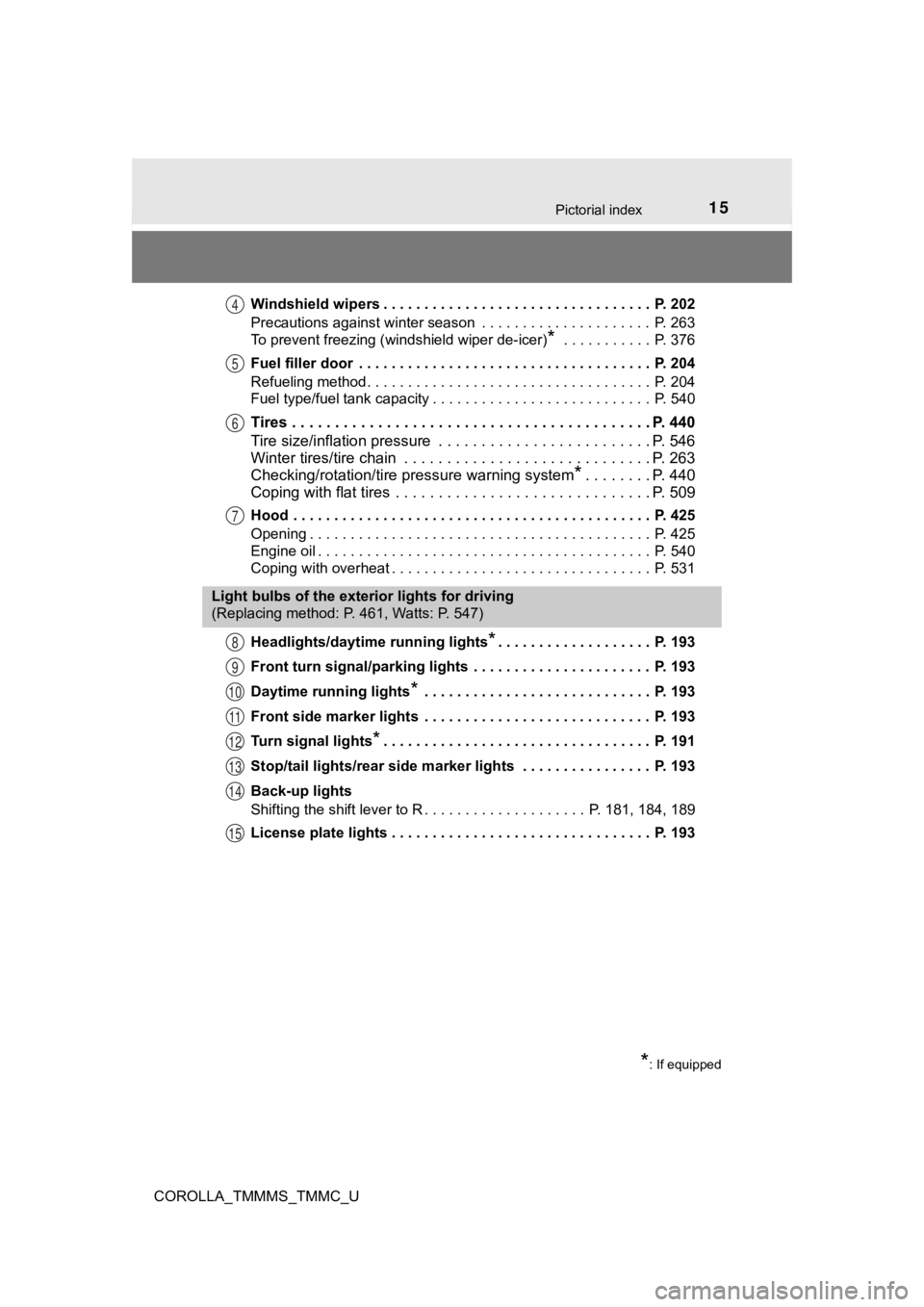
15Pictorial index
COROLLA_TMMMS_TMMC_UWindshield wipers . . . . . . . . . . . . . . . . . . . . . . . . . . . . . . . . . P. 202
Precautions against winter season . . . . . . . . . . . . . . . . . . . . . P. 263
To prevent freezing (windshield wiper de-icer)
* . . . . . . . . . . . P. 376
Fuel filler door . . . . . . . . . . . . . . . . . . . . . . . . . . . . . . . . . . . . P. 204
Refueling method . . . . . . . . . . . . . . . . . . . . . . . . . . . . . . . . . . . P. 204
Fuel type/fuel tank capacity . . . . . . . . . . . . . . . . . . . . . . . . . . . P. 540
Tires . . . . . . . . . . . . . . . . . . . . . . . . . . . . . . . . . . . . . . . . . . P. 440
Tire size/inflation pressure . . . . . . . . . . . . . . . . . . . . . . . . . P. 546
Winter tires/tire chain . . . . . . . . . . . . . . . . . . . . . . . . . . . . . P. 263
Checking/rotation/tire pressure warning system
*. . . . . . . . P. 440
Coping with flat tires . . . . . . . . . . . . . . . . . . . . . . . . . . . . . . P. 509
Hood . . . . . . . . . . . . . . . . . . . . . . . . . . . . . . . . . . . . . . . . . . . . P. 425
Opening . . . . . . . . . . . . . . . . . . . . . . . . . . . . . . . . . . . . . . . . . . P. 425
Engine oil . . . . . . . . . . . . . . . . . . . . . . . . . . . . . . . . . . . . . . . . . P. 540
Coping with overheat . . . . . . . . . . . . . . . . . . . . . . . . . . . . . . . . P. 531
Headlights/daytime running lights
*. . . . . . . . . . . . . . . . . . . P. 193
Front turn signal/parking lights . . . . . . . . . . . . . . . . . . . . . . P. 193
Daytime running lights
* . . . . . . . . . . . . . . . . . . . . . . . . . . . . P. 193
Front side marker lights . . . . . . . . . . . . . . . . . . . . . . . . . . . . P. 193
Turn signal lights
*. . . . . . . . . . . . . . . . . . . . . . . . . . . . . . . . . P. 191
Stop/tail lights/rear side marker lights . . . . . . . . . . . . . . . . P. 193
Back-up lights
Shifting the shift lever to R . . . . . . . . . . . . . . . . . . . . P. 181, 184, 189
License plate lights . . . . . . . . . . . . . . . . . . . . . . . . . . . . . . . . P. 193
4
5
6
7
Light bulbs of the exterior lights for driving
(Replacing method: P. 461, Watts: P. 547)
*: If equipped
8
9
10
11
12
13
14
15
Page 223 of 608
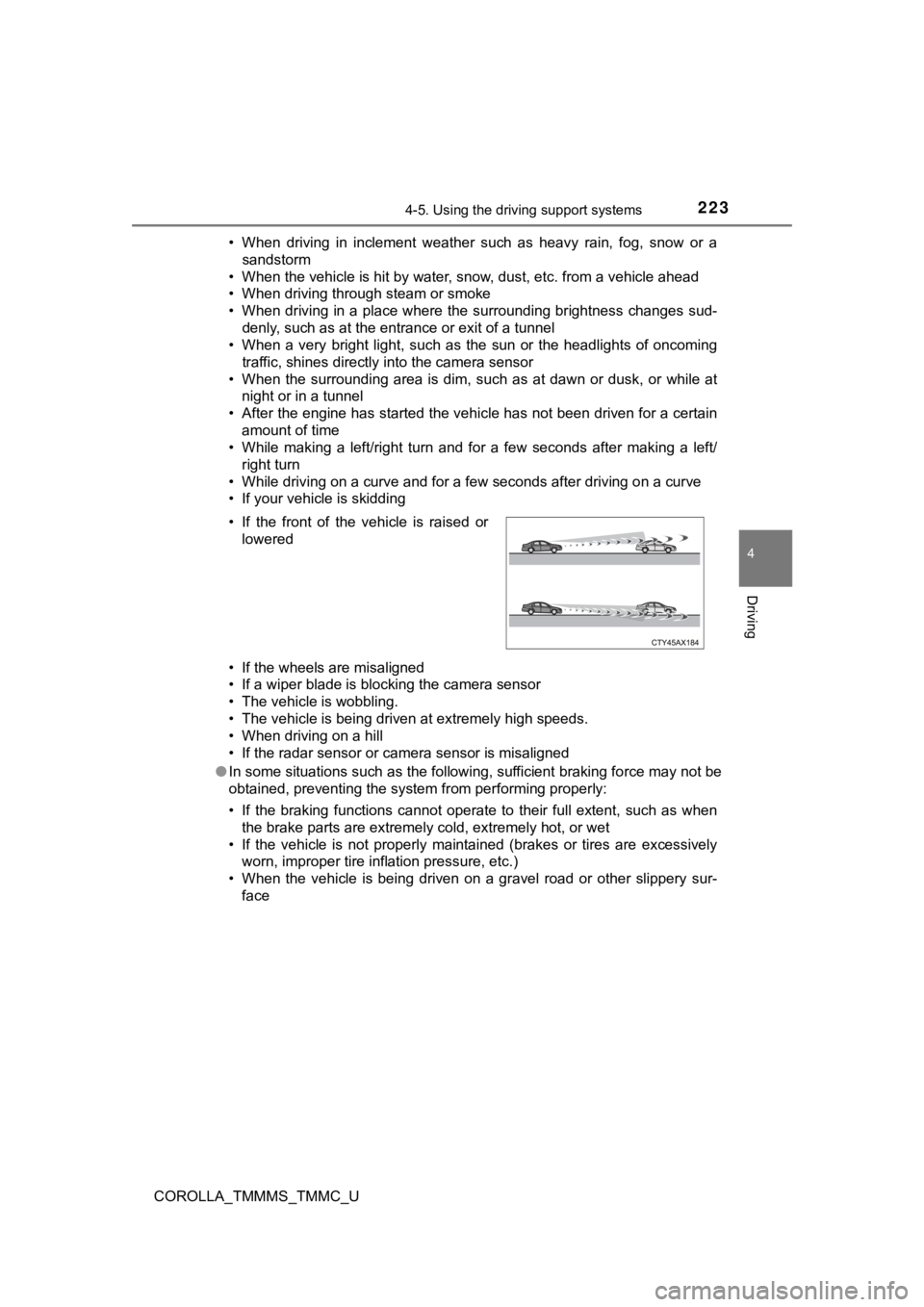
2234-5. Using the driving support systems
4
Driving
COROLLA_TMMMS_TMMC_U• When driving in inclement weather such as heavy rain, fog, snow or a
sandstorm
• When the vehicle is hit by water, snow, dust, etc. from a vehicle ahead
• When driving through steam or smoke
• When driving in a place where the surrounding brightness changes sud- denly, such as at the entrance or exit of a tunnel
• When a very bright light, such as the sun or the headlights of oncoming
traffic, shines directly into the camera sensor
• When the surrounding area is dim, such as at dawn or dusk, or while at
night or in a tunnel
• After the engine has started the vehicle has not been driven for a certain amount of time
• While making a left/right turn and for a few seconds after mak ing a left/
right turn
• While driving on a curve and for a few seconds after driving o n a curve
• If your vehicle is skidding
• If the wheels are misaligned
• If a wiper blade is blocking the camera sensor
• The vehicle is wobbling.
• The vehicle is being driven at extremely high speeds.
• When driving on a hill
• If the radar sensor or camera sensor is misaligned
● In some situations such as the following, sufficient braking fo rce may not be
obtained, preventing the system from performing properly:
• If the braking functions cannot operate to their full extent, such as when
the brake parts are extremely cold, extremely hot, or wet
• If the vehicle is not properly maintained (brakes or tires are excessively
worn, improper tire inflation pressure, etc.)
• When the vehicle is being driven on a gravel road or other sli ppery sur-
face
• If the front of the vehicle is raised or
lowered
Page 262 of 608

2624-5. Using the driving support systems
COROLLA_TMMMS_TMMC_U
WARNING
■Replacing tires
Make sure that all tires are of the specified size, brand, trea d pattern and
total load capacity. In addition, make sure that the tires are inflated to the
recommended tire inflation pressure level.
The ABS, TRAC and VSC systems will not function correctly if di fferent tires
are installed on the vehicle.
Contact your Toyota dealer for further information when replaci ng tires or
wheels.
■ Handling of tires and the suspension
Using tires with any kind of problem or modifying the suspensio n will affect
the driving assist systems, and may cause a system to malfuncti on.
Page 407 of 608

407
7Maintenance and care
COROLLA_TMMMS_TMMC_U7-1. Maintenance and care
Cleaning and protecting the vehicle exterior .......... 408
Cleaning and protecting the vehicle interior ........... 411
7-2. Maintenance Maintenance requirements ................... 414
General maintenance........ 417
Emission inspection and maintenance (I/M)
programs......................... 421
7-3. Do-it-yourself maintenance
Do-it-yourself service precautions ..................... 422
Hood ................................. 425
Positioning a floor jack ...... 427
Engine compartment ......... 429
Tires .................................. 440
Tire inflation pressure ....... 448
Wheels .............................. 451
Air conditioning filter.......... 453
Wireless remote control/ electronic key battery ...... 455
Checking and replacing fuses ............................... 458
Light bulbs......................... 461
Page 420 of 608
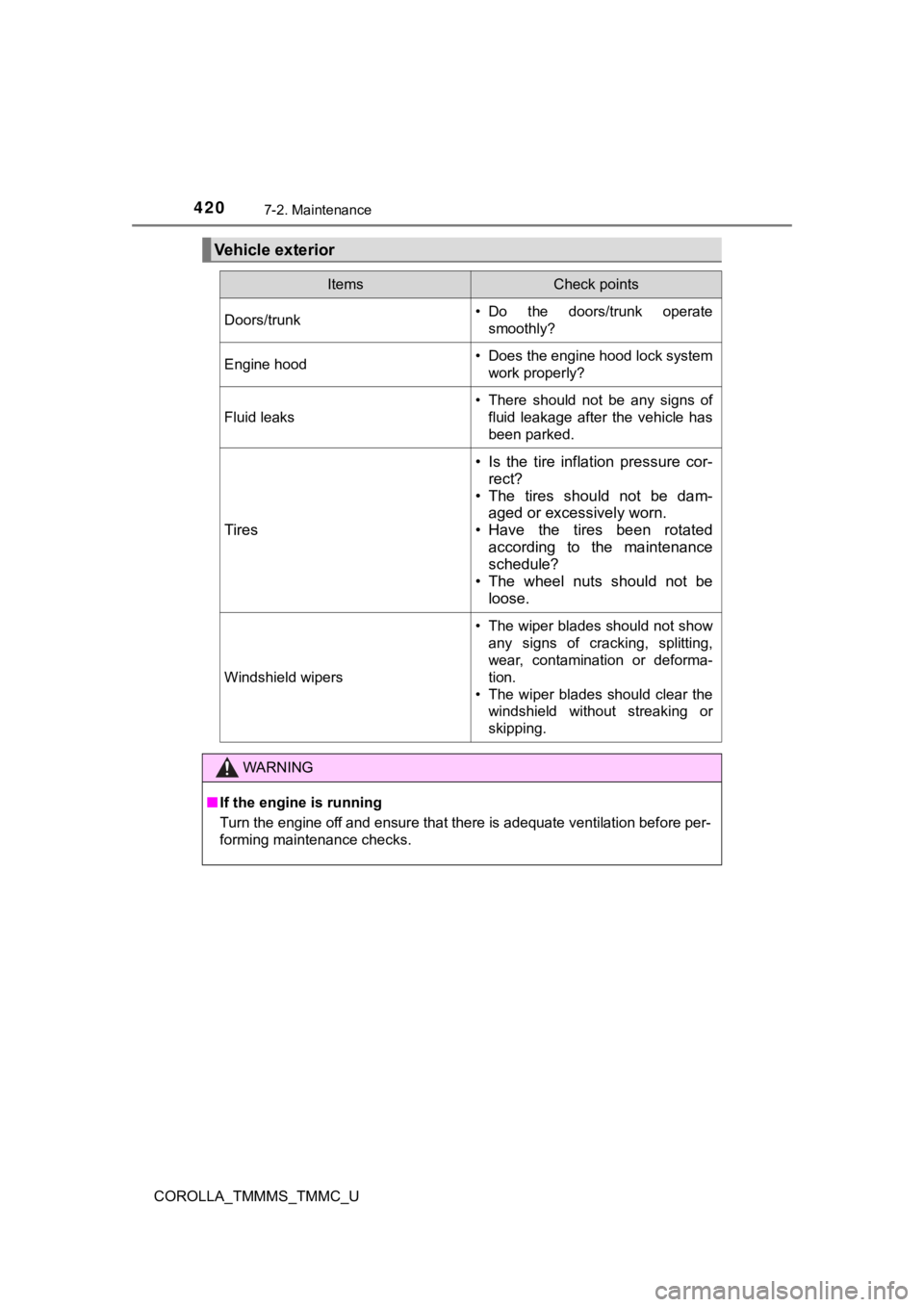
4207-2. Maintenance
COROLLA_TMMMS_TMMC_U
Vehicle exterior
ItemsCheck points
Doors/trunk• Do the doors/trunk operatesmoothly?
Engine hood• Does the engine hood lock systemwork properly?
Fluid leaks
• There should not be any signs offluid leakage after the vehicle has
been parked.
Tires
• Is the tire inflation pressure cor-rect?
• The tires should not be dam- aged or excessively worn.
• Have the tires been rotated
according to the maintenance
schedule?
• The wheel nuts should not be
loose.
Windshield wipers
• The wiper blades should not show
any signs of cracking, splitting,
wear, contamination or deforma-
tion.
• The wiper blades should clear the windshield without streaking or
skipping.
WARNING
■If the engine is running
Turn the engine off and ensure that there is adequate ventilati on before per-
forming maintenance checks.
Page 423 of 608
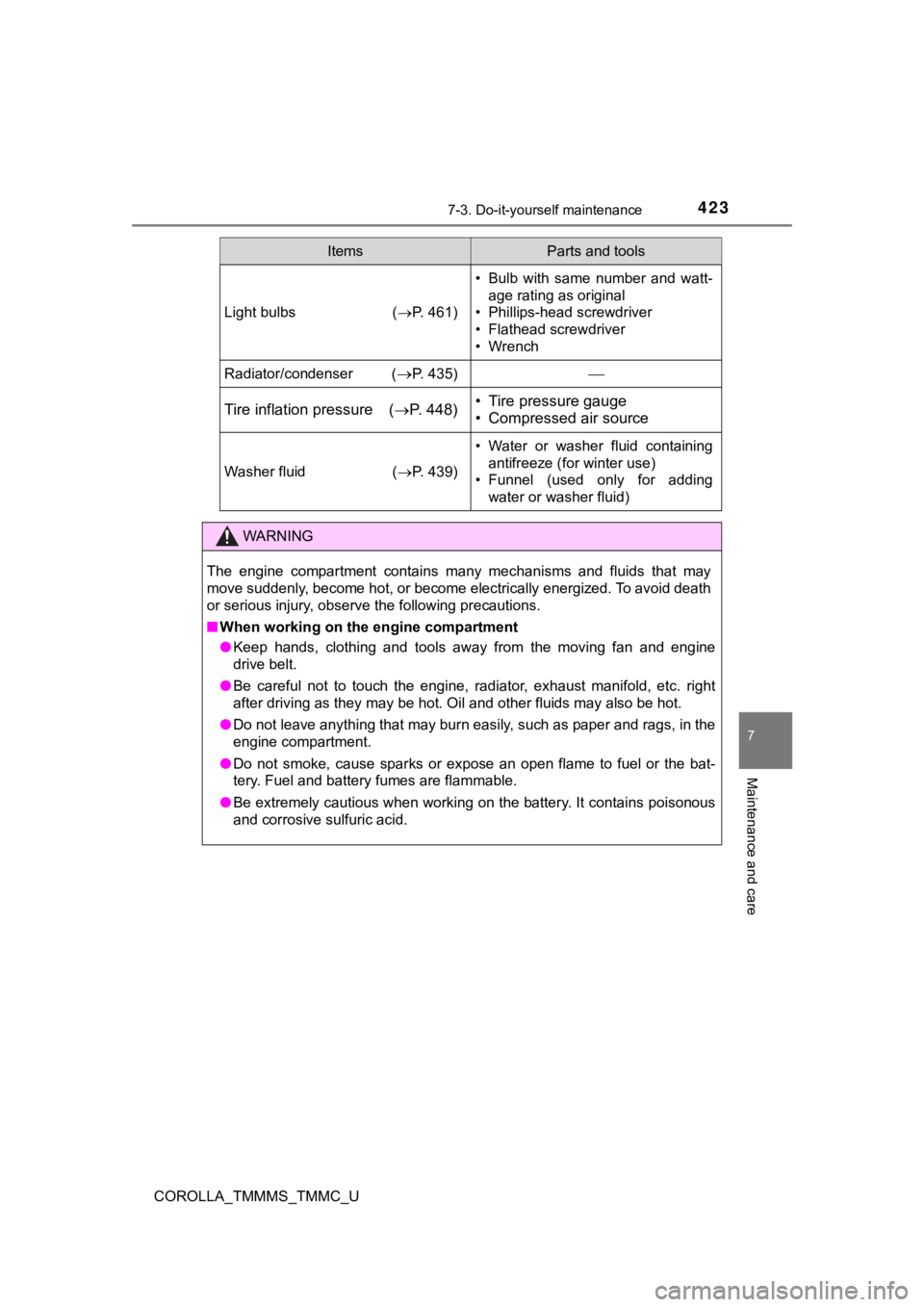
4237-3. Do-it-yourself maintenance
7
Maintenance and care
COROLLA_TMMMS_TMMC_U
Light bulbs(P. 461)
• Bulb with same number and watt-
age rating as original
• Phillips-head screwdriver
• Flathead screwdriver
• Wrench
Radiator/condenser (P. 435)
Tire inflation pressure ( P. 448)• Tire pressure gauge
• Compressed air source
Washer fluid (P. 439)
• Water or washer fluid containing
antifreeze (for winter use)
• Funnel (used only for adding
water or washer fluid)
WARNING
The engine compartment contains many mechanisms and fluids that may
move suddenly, become hot, or become electrically energized. To avoid death
or serious injury, observe the following precautions.
■ When working on the engine compartment
● Keep hands, clothing and tools away from the moving fan and eng ine
drive belt.
● Be careful not to touch the engine, radiator, exhaust manifold, etc. right
after driving as they may be hot. Oil and other fluids may also be hot.
● Do not leave anything that may burn easily, such as paper and r ags, in the
engine compartment.
● Do not smoke, cause sparks or expose an open flame to fuel or t he bat-
tery. Fuel and battery fumes are flammable.
● Be extremely cautious when working on the battery. It contains poisonous
and corrosive sulfuric acid.
ItemsParts and tools
Page 441 of 608

4417-3. Do-it-yourself maintenance
7
Maintenance and care
COROLLA_TMMMS_TMMC_U
Your vehicle is equipped with a tire pressure warning system that uses
tire pressure warning valves and transmitters to detect low tire infla-
tion pressure before serious problems arise. ( P. 480)
◆Installing tire pressure warning valves and transmitters
When replacing tires or wheels, tire pressure warning valves an d
transmitters must also be installed.
When new tire pressure warning valves and transmitters are
installed, new ID codes must be registered in the tire pressure
warning computer and the tire pressure warning system must be
initialized. Have tire pressure warning valves and transmitter ID
codes registered by your Toyota dealer. ( P. 443)
◆Initializing the tire pressure warning system
■The tire pressure warning system must be initialized in the fol-
lowing circumstances:
● When changing the tire size.
● When the tire inflation pressure is changed such as when chang-
ing traveling speed or load weight.
When the tire pressure warning sy stem is initialized, the current tire
inflation pressure is set as the benchmark pressure.
Tire pressure warning system (if equipped)
Page 442 of 608
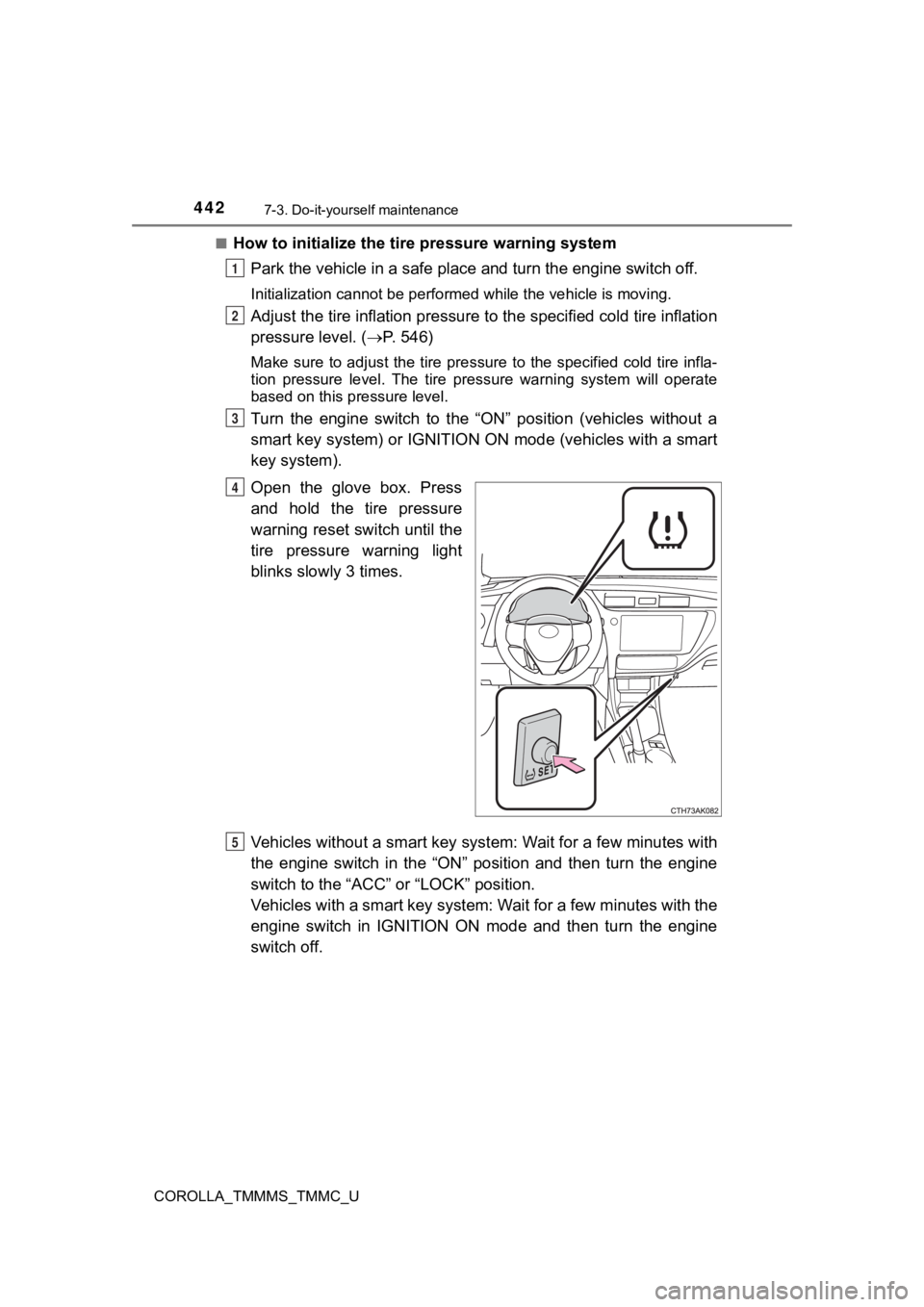
4427-3. Do-it-yourself maintenance
COROLLA_TMMMS_TMMC_U■
How to initialize the tire pressure warning system
Park the vehicle in a safe place and turn the engine switch off .
Initialization cannot be performed while the vehicle is moving.
Adjust the tire inflation pressure to the specified cold tire i nflation
pressure level. ( P. 546)
Make sure to adjust the tire pre ssure to the specified cold tire infla-
tion pressure level. The tire pressure warning system will oper ate
based on this pr essure level.
Turn the engine switch to the “ON” position (vehicles without a
smart key system) or IGNITION ON mode (vehicles with a smart
key system).
Open the glove box. Press
and hold the tire pressure
warning reset switch until the
tire pressure warning light
blinks slowly 3 times.
Vehicles without a smart key syst em: Wait for a few minutes with
the engine switch in the “ON” position and then turn the engine
switch to the “ACC” or “LOCK” position.
Vehicles with a smart key system : Wait for a few minutes with the
engine switch in IGNITION ON mode and then turn the engine
switch off.
1
2
3
4
5
Page 443 of 608

4437-3. Do-it-yourself maintenance
7
Maintenance and care
COROLLA_TMMMS_TMMC_U
◆Registering ID codes
The tire pressure warning valve and transmitter is equipped with a
unique ID code. When replacing a tire pressure warning valve an d
transmitter, it is necessary to register the ID code. Have the ID code
registered by your Toyota dealer.
■When to replace your vehicle’s tires
Tires should be replaced if:
●The treadwear indicators are showing on a tire.
●You have tire damage such as cuts, splits, cracks deep enough t o
expose the fabric, and bulges indicating internal damage
●A tire goes flat repeatedly or c annot be properly repaired due to the size
or location of a cut or other damage
If you are not sure, consult with your Toyota dealer.
■Replacing tires and wheels (vehicles with a tire pressure warning
system)
If the ID code of the tire press ure warning valve and transmitt er is not reg-
istered, the tire pressure warni ng system will not work properly. A f t e r d r i v -
ing for about 20 minutes, the tire pressure warning light blink s for 1
minute and stays on to indi cate a system malfunction.
■Tire life
Any tire over 6 years old must be checked by a qualified techni cian even
if it has seldom or never been u sed or damage is not obvious.
■Routine tire inflation pressure checks (vehicles with a tire pr essure
warning system)
The tire pressure warning system does not replace routine tire inflation
pressure checks. Make sure to chec k tire inflation pressure as part of
your routine of daily vehicle checks.
■Low profile tires (17-inch tires)
Generally, low profile tires will wear more rapidly and tire gr ip perfor-
mance will be reduced on snowy and /or icy roads when compared to
standard tires. Be sure to use snow tires or tire chains on sno wy and/or
icy roads and drive carefully at a speed appropriate for road a nd weather
conditions.